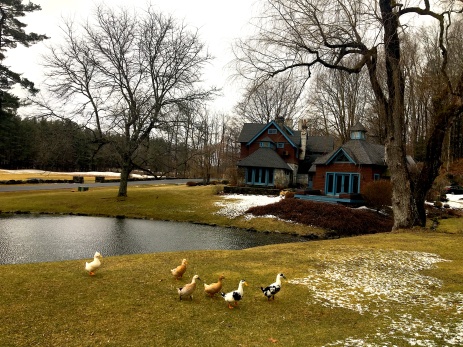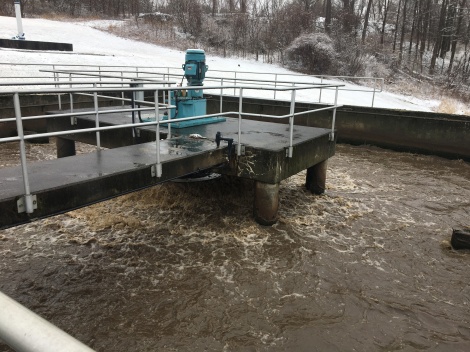Spring 2018

It’s 8:30 pm on Tuesday, February 13th in the basement hallway of the Earth Institute at Columbia University in the City of New York. At one end of the hall is the student lounge where a diligent clan of four talks about their group project on the cost of capital for a hypothetical solar energy project in Mexico for the Clean Energy Financing class. The offices, upstairs and down the hall, are empty. The nighttime security guard is calmly surveying the office because it is the bottom of the hour, just doing his job. This is a typical night early in the semester, except for one thing: the basement hallway stinks… there is garbage laid out, neatly separated, on plastic tarps. A different gang of four students is working diligently on their own group project: conducting their second night of waste audits, a dirty job that all 4 couldn’t wait to get started on.
These four men are part of the Sustainability Management chapter of Net Impact (SUMA Net Impact) project teams, specifically working with the Office of Environmental Stewardship’s (OES) Waste Management Strategy for Columbia. The goal is to gather data that will eventually allow OES to streamline waste collection and management and then make adjustments to reach the ultimate goal of zero waste in 2030. The procedure was:
- Unravel: Lay a large (4 ft x 4 ft) plastic tarp on the hallway floor and overturn the first of 6 separate waste bins onto the tarp. This first bin is labeled “landfill”, so what should be in this bin is material that cannot be recycled and instead sent to the landfill (e.g. non-rigid plastic, soiled paper, food waste, styrofoam, etc.).
- Separate: Carefully separate out materials that can be recycled, such as photocopy paper and soda cans. Separate food waste from the contents of the landfill bin.
- Weigh each category of items to understand how much (in kilograms) of what is in trash bin should go to the landfill, recyclable, or compostable. For this, we used a generic hand-held luggage scale.
- Order of weigh-in: paper (if any), then the plastic and metal recycling (if any), then the “landfill” materials excluding food waste, and finally the food waste (as it is messiest, it always is last to be weighed). All categories are weighed separately, emptying the bag of each before filling it in with the next category of materials.
The final weights prove there’s work to be done in waste management: over half of what is in the landfill bin could have been recycled in an adjacent bin.
The four filth foragers found, over the course of that night and every other iteration (7 total), that separation of specific waste items is challenging. With many discarded products made with a combination of materials, such as cardboard and plastic and metal, or paper products coated in a film that might have been plastic or wax, the task of waste management becomes bewildering.
After the first night of auditing, and confirmed in the following 6 nights, they were pleasantly surprised to find that, if all waste were disposed of in its proper place (paper, metal, glass and rigid plastic recycled, non-rigid plastic in the landfill), and if there were a food waste only bin (to be turned into compost), then less than 5% of total materials disposed would have been legitimate landfill waste by NYC standards. That’s a number that reads like progress, like a cleaner, greener, more sustainable city. That’s a number with impact.
In other parts of the waste stream, custodial services commonly get complaints that the bathrooms are dirty and yet most administrators on campus are not willing to switch to hand dryers and in general paper towels are seen as more effective, convenient, and sanitary by users. This was substantiated by a survey conducted by the Net Impact team. Students and faculty were asked to about preference between paper towels and hand dryers, whether they were aware that one was more environmentally friendly, cost-effective, and hygienic than the other, and whether they would switch if environmental, cost and health information was available to them. 50% of survey respondents thought that paper towels are more environmentally friendly than hand dryers or indicated that they did not know. But 67% said they would change their behavior.
As another media blow up on the health impact of hand dryers rolled through the US, a team of SUMA Net Impact students (Keren Kuperman, Abdulla Alishaq, and William Teng) was working diligently to see how Columbia University can reduce paper towel use. The team reviewed research and calculations published on lifecycle greenhouse gas emissions of hand dryers and paper towels and calculated cost savings based on actual cost and consumption data provided by Custodial Services. They found that hand dryers emitted less than 15% of lifecycle greenhouse gas emissions than paper towels (the university purchases 100% recycled content paper towels). The university can also save over half of their monthly expense by switching to hand dryers. So what about that germ-spewing hand dryer warning in the media? Well, published studies on paper towels being more hygienic than hand dryers come from the medical field (hospitals and medical schools), where the utmost care is needed in keeping the facilities and hands clean. But for an average person, to say that hand dryers are dangerous is overkill. In New York City, as soon as you washed your hands, you probably already came in contact with doors, handrails, and surfaces that are covered in far more germs.
Net Impact is working with the Office of Environmental Stewardship and Custodial Services to develop signs that provide environmental information to try to reduce paper towel consumption on campus. Don’t worry, paper towels are not going away, but please do your part and use fewer paper towels.
Simultaneously, project team members Stephanie Hoyt and Sylwia Zieba interviewed the waste manager at Facilities, manager of Custodial Services, the Sustainability team at Columbia, others working to improve recycling on campus, and other higher education institutions. What they found was a complex system of waste management with many players that don’t have a platform to collect and share information. They began building an Excel-based dashboard to track waste tonnage provided by the NYC Department of Sanitation.
Net Impact is planning to work with the Office of Environmental Stewardship to gather other diverted waste data to add to the spreadsheet and to make the input more streamlined. The goal is for the data collection and dashboard system to go online in the future for better collaboration and transparency.

Here were our takeaways and thoughts:
- Success in Unified Communication: The nuance and detail of waste disposal in Manhattan are, surprisingly and unfortunately, complicated. Unifying the communication is a key driver to motivating engagement. The rules are complicated and always changing, and the problem is massive. The waste management issue will continue to be evolving and as long as we are moving forward in improvements, then we are in the right place.
- You Can Only Manage What You Measure: In the Sustainability Management program, students constantly hear an adaptation of the famous saying by Peter Drucker that you can’t manage what you don’t measure. After working with the Office of Environmental Stewardship in the fall of 2017, SUMA Net Impact members realized that Columbia University’s waste management and the sustainability teams needed a centralized system to track and measure waste diversion rates on campus. But before we can even tackle building a system, we needed a better understanding of how waste is managed on campus and whether there are peer universities with successful waste diversion programs that we can learn from.
- Paper Towels vs. Hand Dryers: Every month 15 tons (equivalent to almost 1150 miles of paper towels if unrolled) of paper towels are ordered and used on the Morningside Campus. That is a significant cost for the university, not to mention the cost of labor associated with collecting the used paper towels and cleaning bathrooms that have been littered with paper towels.
Written by:
Clayton Michael Colaw, Project team member










